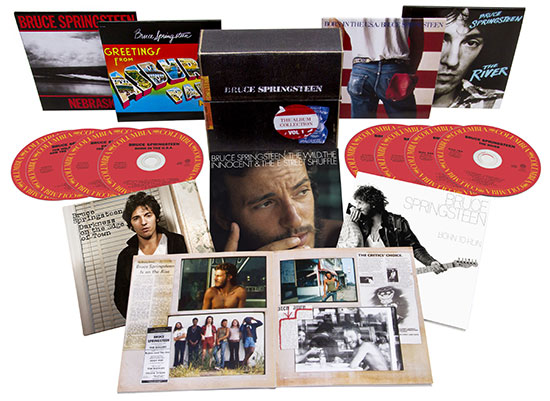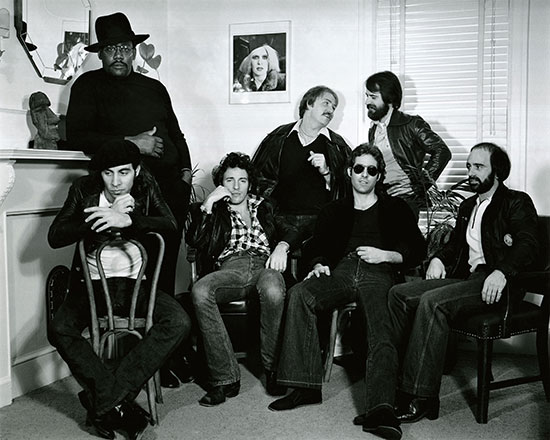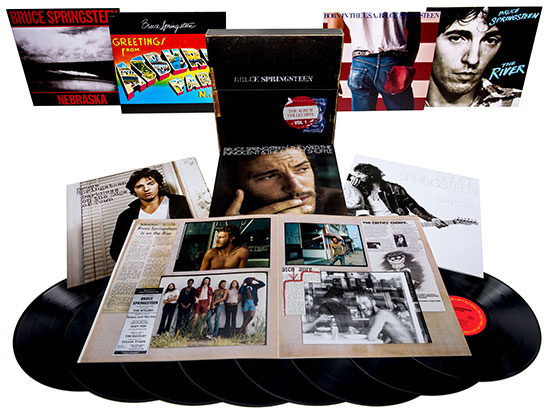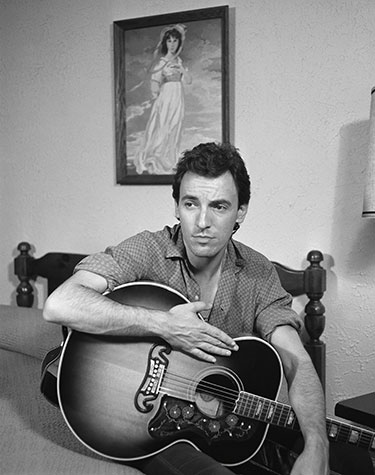
This November, Columbia Records/Legacy Recordings is set to release a box set that utilizes state-of-the-art technology to revisit several of Springsteen’s classic recordings: the incredible run of albums from his first decade in the studio. Bruce Springsteen: The Album Collection Vol. 1 1973-1984 contains newly remastered editions of Springsteen's first seven LPs, Greetings From Asbury Park, N.J. through Born in the U.SA, and will be available in both vinyl and CD configurations.
Since 1992, when Columbia reissued Born to Run in a gold-CD MasterSound edition, many fans have hoped for remastered upgrades to the rest of Springsteen's catalog for the digital age; in the 22 years since, only Born to Run and Darkness on the Edge of Town have received that treatment, as part of their respective box sets. The wait ends here, including fresh remasters of BTR and Darkness, which benefit from a previously unavailable tape transfer technique — more on that in a moment.
Greetings From Asbury Park, N.J. (1973)
The Wild, the Innocent & the E Street Shuffle (1973)
Born to Run (1975)
Darkness on the Edge of Town (1978)
The River (1980)
Nebraska (1982)
Born in the U.S.A. (1984)
All seven of the albums are newly remastered, five for the first time ever, and all are making their remastered debuts on vinyl. Original LP packaging is being replicated for each, and the box set also includes a 60-page book featuring rarely seen photos, memorabilia, and original press clippings from Springsteen's first ten years as a recording artist.

For the audio, renowned mastering engineer Bob Ludwig is again at the helm. A partner to Springsteen since coming in to assist with the challenges of Nebraska in '82, Ludwig has handled mastering for the vast majority of Springsteen's output over the last 30 years, as well as the remastering: he was the ears for Born to Run's '92 MasterSound reissue and its 30th Anniversary remaster, along with the 2010 edition of Darkness on the Edge of Town for The Promise box set.
Backstreets recently had a chance to speak with Ludwig, to find out further details about what this massive project entailed and what listeners can expect.
We first heard a sampling of the catalog upgrade earlier this year, when a number of Springsteen albums spanning the past 40 years were made available on iTunes in newly remastered form. Ludwig confirms that Apple's 'Mastered for iTunes' initiative was the catalyst for this effort. "Mastered for iTunes slowly started three years ago," he says, "but it's now pretty standard for any new project. It involves starting from 24-bit sources instead of the CD's 16-bit standard, from which all downloads were formerly created."
The Plangent Process
"Bruce, Jon Landau and [engineer and audio archivist] Toby Scott wanted to make his early catalog have optimum quality going forward," Ludwig says. A key element of this optimization is a newly developed method of transferring original masters to digital, for archival or remastering purposes.
"A technique invented by Jamie Howarth called the Plangent Process had been deployed since the last time the catalog was mastered," Ludwig explains. "The process allows the tape playback to sound closer to the output of the mixing console than ever before. It yields better separation, less distortion and a solidity to the sound that can be really remarkable." Recovering lost frequencies and digitally correcting wow and flutter and other timing issues, the Plangent Process reveals, as Ludwig puts it, "a sonic depth and clarity not heard since the original mix-down session." Neil Young and Grateful Dead are two artists that have already embraced Plangent for their reissues.
After a listening to a test run a few years back, a Plangent transfer of Darkness, Ludwig says, "Bruce encouraged remastering the entire catalog."
Luckily, there were no bumps in the road when it came to finding the original stereo masters. "Unlike many situations that seem to occur with increasing frequency where master tapes have been lost or damaged in a fire," Ludwig says, "Toby Scott has kept a database of all of Bruce's recordings, and Sony has a good storage system. The tapes were all where they should be. Toby told me most of the tapes were in good condition: Some needed baking to remove the 'sticky-tape syndrome' problem that makes many masters un-playable when taken out of storage, others did not."
So after baking for playback as needed, Scott transported the master tapes to the Plangent facility for transfer — but they didn’t go straight from there to Ludwig. "That master was sent to Bruce for review and approval. Then I got those high-resolution Plangent transfers with instructions to re-master them using all that I have learned and utilizing improvements in technology, while still maintaining the original intent for the sound of the album."
"When I first heard the Plangent transfers," Ludwig recalls, "I didn’t expect that the first three albums especially would sound so suddenly clear and full of depth. I knew these albums very well — no, they are not in my DNA, as some Backstreets readers seem to have, but I was hearing parts that had never stood out before, and the arrangements seemed to come together in a way that I was literally hearing for the first time. The horns and percussion on 'E Street Shuffle,' the guitars on 'Sandy'… it's all great."
"If it sounds good, and feels good…"
When it comes to the actual remastering, the desire to get it "just right" can prove vexing with such familiar and beloved material, but Ludwig boils down his approach to this: "As Duke Ellington said, 'If it sounds good, and feels good, it is good.'"
Of course, he isn't the only one making that call. Springsteen, Ludwig says, "will go to any lengths to prove to himself that what he has is as good as it can be…. He will not stop until the song or album has been reviewed and turned over as many times as it takes to conclude that it is what he wants."
And what does Bruce want? "I think it is like that Duke Ellington quote. If it sounds better, by his personal criteria, it’s approved."
Given the varying opinions in the digital age about what sounds good and what feels good, we asked Ludwig for his take on compression and the "Loudness Wars." He says he "tried to keep the older recordings — that exist in the rather non-compressed world in which they were created — dynamic. They should still sound like vintage Bruce, but better-sounding vintage Bruce!"
"I hate over-compression," Ludwig continues, "but for rock music there is a sweet-spot where compression adds excitement, punch and very musical glue to the sound. Going past that point — that is, the Loudness Wars — can sound exciting in a direct A/B comparison, but when listening to an entire album it becomes fatiguing to the ears. It’s always a trade-off. There are a few albums where originally Bruce wanted to use some compression, and the remasters have a little less. It is a balance, and a question of what 'feels good' that day."
"Being human, an artist can only determine what sounds good to them at that moment," Ludwig qualifies. But as for his own part in the process, "Every time I’ve had the opportunity and extreme honor to master any of Bruce’s music, I’m always trying to create as much musicality as I can from the mixes."

Formats and the future
That musicality is something vinyl listeners in particular should notice. "The LPs are cut from the high-resolution digital masters," Ludwig notes, "so they are from 24-bit sources, and on a great system they should sound a little better than the CDs in some aspects. We got to use some of the best pressing plants in the world for these. I joke that if the major record companies had been using these plants during the original days of vinyl, there would never have been any complaints about ticks, pops and surface noise."
The remasters will be coming not only to vinyl, CD and iTunes, but also other digital services like Spotify. There's even a chance that high-res digital files may become available: "I believe Sony is talking with HDTracks and other high resolution file download services…. Bruce and Sony want to make the new versions available in all formats."
Other albums already released digitally as part of the Mastered for iTunes series — including We Shall Overcome: The Seeger Sessions, Working on a Dream, and Wrecking Ball — are, of course, not part of this set. But the fact that they've already been remastered in 24-bit suggests (as does the Vol. 1 in the title of this new box set) that we can anticipate another wave further on up the road. Asked if that's the plan, Ludwig is direct: "Yes. I have already started on the remainder of the catalog. But those albums were mixed to digital, so it is more a matter of finessing the original to retain the intent while improving the fidelity and creating 24-bit final masters."
The River and Nebraska
The initial Mastered for iTunes batch did not include The River or Nebraska; those two remasters will be available here for the first time. The River is the one that has long been held up as the catalog title most in need of revisiting. Since the 1980 double album was originally mixed digitally, there weren't the speed issues of earlier records. But there was clearly room for improvement, says Ludwig: "When The River was first done and first remastered for CD, there were no digital domain consoles, and the analog-to-digital converters were not nearly as good as they are now, so I hope people will be pleased by the new version. For me, I thought it needed some warmth, and the new one has it."
 Nebraska, given the nature of its origin, has always been tricky. That material was famously recorded to cassette, which caused many engineering headaches when preparing the album for release in 1982. Fortunately, Ludwig didn't have to go back as far as the mix-down cassette Bruce carried in his pocket. He explains that for the other six albums in the box, "we used all the original 1/4-inch, two-track mix masters, so nothing needed to come from multi-track. Nebraska was the exception. The original album was mixed to a cassette, and we could not cut vinyl from that, so during those Nebraska sessions, I made a 1/2-inch master reel which contains the correct takes, edited together, at the correct speed and with the correct azimuth Bruce wished for the album. That reel was used for the original vinyl cut, cassette masters and CD mastering, and it is what we worked from here."
Nebraska, given the nature of its origin, has always been tricky. That material was famously recorded to cassette, which caused many engineering headaches when preparing the album for release in 1982. Fortunately, Ludwig didn't have to go back as far as the mix-down cassette Bruce carried in his pocket. He explains that for the other six albums in the box, "we used all the original 1/4-inch, two-track mix masters, so nothing needed to come from multi-track. Nebraska was the exception. The original album was mixed to a cassette, and we could not cut vinyl from that, so during those Nebraska sessions, I made a 1/2-inch master reel which contains the correct takes, edited together, at the correct speed and with the correct azimuth Bruce wished for the album. That reel was used for the original vinyl cut, cassette masters and CD mastering, and it is what we worked from here."
Born to Run and Darkness on the Edge of Town
Springsteen's 1975 and 1978 classics have been remastered before, but Ludwig confirms that these are indeed new versions of Born to Run and Darkness, not the ones that appeared in their corresponding box sets.
For an album that's been remastered as many times as Born to Run, what's left that can be done? According to Ludwig, it starts at the very beginning: "If you listen carefully to the opening four notes of the piano and harmonica on 'Thunder Road,' they always sounded a little 'shaky' to me. The Plangent Process magically fixed this problem; it sounds as it would be played in real life."
Don't expect a BTR overhaul, though. By the time of his 2005 remaster for the 30th Anniversary of Springsteen's masterpiece, Ludwig had it nailed to the point where he received "the ultimate compliment" from Springsteen: "When I got to remaster Born to Run for the anniversary box set, I saw Bruce backstage, and he told me that he was listening while driving in his car and that he heard Born to Run as he’d originally intended it to sound for the first time!... So I wasn’t about to change the approach. Yet, to me, the new transfers gave it even more life than before, and thus there are some subtle differences to the way something would be EQ'd. There would be less EQ now, as the originals sounded that much better from the get-go." The same goes for Darkness on the Edge of Town.
"Do they sound different? Absolutely!" Ludwig declares. "If I didn't already have them, I'd go out and buy the new versions — and this is from a fan, not a marketing person."
Bruce Springsteen: The Album Collection Vol. 1 1973-1984 will be released on November 17.
Backstreet Records will be carrying both configurations; watch this space, and we'll make an announcement when we begin taking pre-orders.
- September 24, 2014 - Christopher Phillips reporting - photographs of Springsteen and the E Street Band by Frank Stefanko






